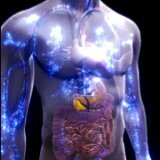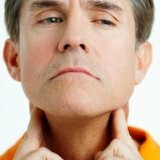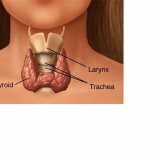Androgenic alopecia in women
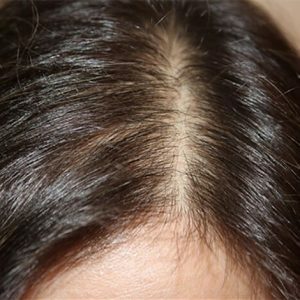
Abundant hair loss is a fairly common problem.Most often, hair loss on the background of hormonal imbalance( or androgenic alopecia) occurs in males.But cases where the female body suffers from this kind of disease are not uncommon.
The occurrence of androgenic alopecia in women is often caused by a violation of the hormonal background - a shift in the balance towards an increase in the number of male hormones. The direct cause of the disease in a number of cases is called hyperandrogenism( ovarian production of the male hormone androgen).Alopecia in women has a number of characteristics that distinguish it from male pattern baldness.
Table of contents: Reasons for the occurrence of alopecia in women The developmental stages of androgenetic alopecia in women Symptoms of androgenic alopecia in women Complications with alopecia Diagnosis of androgenic alopecia in women Treatment of androgenic alopecia in women Prevention of disease Compliance with diet for androgenic alopecia in women Folk remedies for the treatment ofThe causes of alopecia in women
Among the factors that provoke the development of this disease are:
- stress;
- hormonal failure in the body.
Note: symptoms of androgenic alopecia can occur after a short time after a stressful situation.This feature greatly complicates the establishment of the causes of the disease and its diagnosis in general.
The reasons for changing the hormonal background include:
-
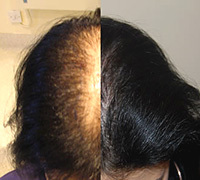 receptions of hormone-containing contraceptives;
receptions of hormone-containing contraceptives; - menopausal changes in the body;
- pregnancy and lactation;
- adherence to an unbalanced diet that is too restrictive;
- taking certain medications( eg, antitumor drugs);
Stages of development of androgenic alopecia in women
For the identification of specific stages of the disease, in some cases, the causes of alopecia are to be taken into account.
According to Hamilton's classification, such stages of androgenic alopecia in women are determined:
- Stage 1. The hair growth line in the forehead region begins to be isolated from the total mass by visible hair thinning.
- Stage 2 . In the parietal zone of hair growth, visible bald patches form near the forehead.
- Stage 3. Hair in the parietal zone( up to the nape of the neck) begins to drop out actively.The bald patches become visually conspicuous.
- Stage 4. A large bald patch is formed, which originates from the hair growth line on the forehead and passes into the occipital region.
Important: this classification applies to patients who do not have endocrine system diseases.With endocrine abnormalities, alopecia is characterized by the rapid spread of bald patches and abundant hair loss in a short time.
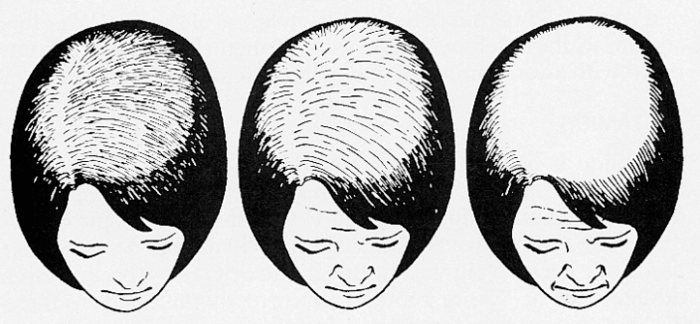
Symptoms of androgenetic alopecia in women
One of the first symptoms of the disease is the thinning of the hair cover in the parting area.Visually, this can be determined by close inspection.
Primary manifestations of alopecia in women also include:
- tarnish and noticeable brittleness of hair;
- appearance of dandruff( in some cases, seborrheic dermatitis);
- rapid hair follicle infusion;
- occurrence of rashes or acne on the scalp;
- appearance of dark hard facial hair;
- violation of the menstrual cycle( until the termination of menstruation).
Complications of alopecia
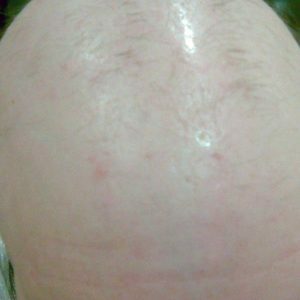 There are many methods of treating baldness, which are directed directly at the restoration of the hairline.All of them give a certain effect provided that they are applied in a timely manner. If the process of active hair loss lasts more than three years, then the treatment of alopecia in this case may be ineffective.
There are many methods of treating baldness, which are directed directly at the restoration of the hairline.All of them give a certain effect provided that they are applied in a timely manner. If the process of active hair loss lasts more than three years, then the treatment of alopecia in this case may be ineffective.
To a number of serious complications caused by hormonal imbalance, many pathologies of internal organs can be attributed.
Diagnosis of androgenetic alopecia in women
This disease requires the submission of a number of tests that can help identify androgenic alopecia.
When diagnosed, the trichologist takes into account:
- results of analysis of the level of sex hormones in the body;
- analysis of thyroid hormone levels;
- is the result of a phototrichogram that gives information about the general condition of the hair and the density of its growth;
- biochemical blood test to determine the level of trace elements and vitamins in the body;
Treatment of androgenic alopecia in women
The treatment of the disease includes preparations for both internal and external use.
For external use, trichologists recommend the use of :
- "Chronostim", "Trichokam" - lotions on a herbal basis;
- Mortar Minoxidil.
 The drug treatment of androgenic alopecia presupposes the administration of cyproterone acetate in parallel with preparations containing estrogen.
The drug treatment of androgenic alopecia presupposes the administration of cyproterone acetate in parallel with preparations containing estrogen.
Radical methods of treatment include surgical hair transplantation.This procedure is appropriate for large foci of alopecia.
Important: The use of drugs should be carried out by the ONLY by the designation of the trichologist after undergoing all necessary tests.Uncontrolled use of medications can aggravate the development of the disease and make it impossible to completely restore the hair in the future.
Prevention of the disease
To preventive measures that reduce the risk of androgenetic alopecia are:
-
 Systematic visit to the doctor by women during menopause.
Systematic visit to the doctor by women during menopause. - Regular careful observation by a specialist during pregnancy and lactation.
- Obligatory consultation of a gynecologist before taking hormonal contraceptives.Avoidance and prevention of stressful situations.In this case, we recommend dancing and yoga classes to relieve emotional stress.In some cases it is recommended that the therapeutic course be passed by a specialist psychologist.
- Balanced nutrition, the use of vitamin complexes in the autumn and spring periods.
- Use of quality hair care products.
- Wearing a headdress at low temperatures and during a stay in the active sun.
Compliance with diet for androgenic alopecia in women
A special diet will significantly improve the effectiveness of treatment of the disease.
The ration should not contain:
- Smoked products;
- Fried and greasy food;
- Carbonated beverages;
- Spicy dishes with an excessive amount of seasoning;
- Alcoholic beverages;
- Tobacco products;
Recommended products:
- Vegetables and fruits in fresh or cooked form;
- Dairy and sour-milk products;
- Foods high in protein( meat, fish, eggs) in boiled or stewed;
Note: additional therapeutic effect will be observed when combining a special diet with the use of chemist's vitamin complexes.
Folk Remedies for the Treatment of Disease
The use of natural ingredients in various masks and hair conditioner for home hair can give a positive effect on the initial stages of the disease.
The undeniable advantages of folk remedies are the availability of the ingredients of the preparations, the simplicity of the preparation of the medicinal formulations, the low cost of the components, and the low probability of side effects.
To strengthen hair often involve henna, basma, decoction of nettle, burdock, honey, onion, yeast mask.
The disadvantages of this type of therapy include: the body's intolerance to some components of home remedies and allergic reactions to them, the lack of any visible effect in later stages of the disease.Categorically it is not recommended to use folk remedies in the presence of skin diseases.
Important : folk remedies can not replace medication.They are relevant only as an adjunct in conjunction with other therapeutic measures.Use of home-made formulations requires a preliminary consultation of a trichologist.
Natalia Tavaluk, medical observer of

